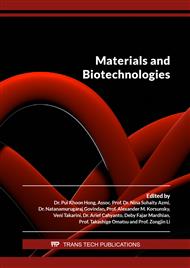[1]
Atay A,Overview of Maxillofacial Prosthetics, Nova Biomedic, New York, (2013).
Google Scholar
[2]
de Caxias FP, dos Santos DM, Bannwart LC, de Moraes Melo Neto CL, Goiato MC, Classification, History, and Future Prospects of Maxillofacial Prosthesis, Int J Dent. 2019 (2019) 1–7.
DOI: 10.1155/2019/8657619
Google Scholar
[3]
Reddy Jr, Kumar Bm, Ahila S, Rajendiran S, Materials in maxillo-facial prosthesis, J Indian Acad Dent Spec Res. 2 (2015) 1.
DOI: 10.4103/2229-3019.166094
Google Scholar
[4]
Alqutaibi AY, Materials of facial prosthesis: History and advance, Int J Contemp Dent Med Rev. (2015) 215.
Google Scholar
[5]
Barhate AR, Gangadhar SA, Bhandari AJ, Joshi AD, Materials used in maxillofacial prosthesis: A review, Pravara Medical Review. 7 (2015) 5–8.
Google Scholar
[6]
Abraham HM, Krishanga S, Philip JM, Venkatakrishnan CJ, Chandran CR, A review of materials used in maxillofacial prosthesis - part 2, Drug Invent Today. 10 (2018) 1569–73.
Google Scholar
[7]
Manappallil J, Maxillofacial Prosthetic Materials, Basic Dent Mater. 3 (2016) 572.
Google Scholar
[8]
Totu EE, Cristache CM, Pereieany VS, Burlibasa M, Petre DC, Burlibasa L, Are nano TiO2 inclusions improving biocompatibility of photocurable polytimethylsiloxane for maxillofacial prothesis manufacturing, Appl. Sci, 11 (2021) 1-14.
DOI: 10.3390/app11093777
Google Scholar
[9]
Badan Pengawas Obat dan Makanan Indonesia. Badan Pengawas Obat dan Makanan Republik Indonesia. 88 (2009) 1–155.
DOI: 10.30649/ph.v21i2.16
Google Scholar
[10]
Cruz RLJ, Ross MT, Powell SK, Woodruff MA, Advancements in Soft-Tissue Prosthetics Part B: The Chemistry of Imitating Life, Front Bioeng Biotechnol. 8 (2020) 1–23.
DOI: 10.3389/fbioe.2020.00147
Google Scholar
[11]
Djustiana N, Takarini V, Hasratiningsih Z. Preliminary study on cells viability based on toxicity effect of varnish fluoride made from Indonesian de-waxed shellac. Padjadjaran Journal of Dentistry. 31 (2019) 136-141.
DOI: 10.24198/pjd.vol31no2.22657
Google Scholar
[12]
Pintor Avb, Queiroz LD, Barcelos R, Primo LSG, Maia LC, Alves GG, MTT versus other cell viability assays to evaluate the biocompatibility of root canal filling materials : a systematic review, International Endodontic Journal. 52 (2020) 1348-73.
DOI: 10.1111/iej.13353
Google Scholar
[13]
Bal BT, Yilmaz H, Aydin C, Karakoca S, Yilmaz S, In vitro cytotoxicity of maxillofacial silicone elastomers: effect of accelerated aging, Wiley Interscience. (2008) 122-6.
Google Scholar
[14]
Akay C, Cevik P, Karakis D, Sevim H. in vitro cytotoxicity of maxillofacial silicone elastomer: effect of nano-particles. Journal of Prosthodontics. (2016) 1-4.
DOI: 10.1111/jopr.12533
Google Scholar
[15]
ISO10993-5. Biological Evaluation of Medical Devices-Part 5: Test for in vitro cytotoxicity. (2009) 28.
Google Scholar
[16]
Sumarta NPM, Danudiningrat CP, Rachmat EA, Soesilawati P. Cytotoxicity difference of 316L stainless steel and titanium reconstruction plate. Dent J. 44 (2011) 7-11.
DOI: 10.20473/j.djmkg.v44.i1.p7-11
Google Scholar
[17]
Ansarifar A, Lim BY. Reinforcement of silicone rubber with precipitated amorphous white silica nanofiller-Effect of silica aggregates on the rubber properties. Artic J Rubber Res. 9 (2006) 140–58.
DOI: 10.5254/1.3547914
Google Scholar
[18]
Mohammad P, Abbasinia M, Assari MJ, Oliaei M. the toxicology of silica nanoparticles: a review. Toxicological & environmental chemistry. (2018).
DOI: 10.1080/02772248.2018.1485921
Google Scholar
[19]
Kopylov VM, Kostyleva EI, Kostylev IM, Koviazin A V, Silica fillers for silicone rubber, Int Polym Sci Technol. 38 (2011) 35–47.
DOI: 10.1177/0307174x1103800408
Google Scholar
[20]
Kalamarz I, Chladek G, Pokój M, Łukowiec D, Krawczyk C, Stencel R, et al. The properties of experimental silicones reinforced with silica fillers for dentistry. Arch Mater Sci Eng. 81 (2016) 22–9.
DOI: 10.5604/18972764.1229622
Google Scholar
[21]
Kohls DJ, Schaefer DW, Kosso R, Feinblum E. Silica fillers for elastomer reinforcement. Curr Top Elastomers Res. (2008) 503–16.
DOI: 10.1201/9781420007183-17
Google Scholar
[22]
Mebert AM, Baglole CJ, Desimone MF, Maysinger D. Nanoenginered silica: properties, applications, and toxicity. Food and Chemical toxicology. 109 (2017) 753-70.
DOI: 10.1016/j.fct.2017.05.054
Google Scholar
[23]
Wang L, Chen Hu MS, Qi Liu MS, SHao L. The effect of artificial ageing on cytotoxicity of nano-TiO2 silicone elastomer. J. Biomater. Tissue Eng. 5 (2015) 996-1002.
DOI: 10.1166/jbt.2015.1408
Google Scholar



